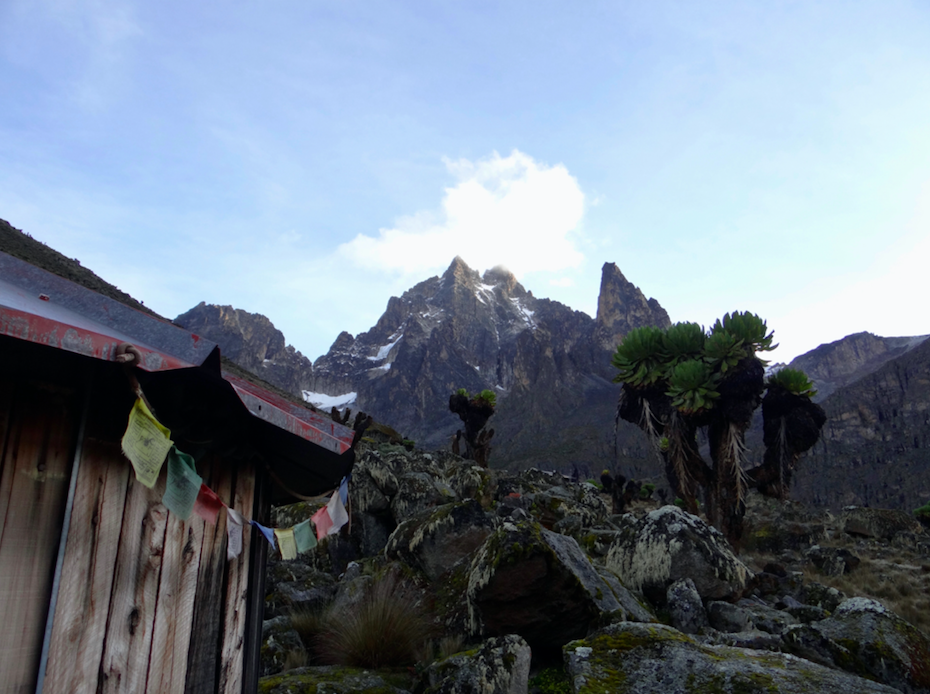Self-isolation on Mount Kenya
Towards the end of March there were rumors going round Kenya that there’d be a complete lockdown. Naturally people were anxious. It hasn’t happened though. A few counties have been cordoned off, but there is yet to be a complete lockdown. It’s unlikely to happen. Not in a country where practically everyone’s daily bread is found beyond the doorstep. Our uchumi, our economy, is out there in the colourful hustle and bustle of shoe shiners, fruit sellers, boda boda’s, bakers, hawkers and chapati makers. And all the rest.
The government, already crippled by debt pre-COVID, haven’t the funds to adequately compensate all the citizens, were they to actually try and coop everyone up. So, despite certain restrictions, they have wisely chosen to let the show go on. It has been a similar case in most other African countries. No one wants a riot. Anyway, I’m rambling my way towards the fact that this relative freedom meant you could still get out and about, to an extent that many others in the world no longer could.
“It was not merely a single mountain, he told me; it was a whole country of its own and parts of it were still unexplored. His descriptions of its wild grandeur, its glaciers and precipices, its valleys full of flowers and its surprisingly blue tarns set down here and there in the wastes of rock, filled me with a longing to be off.” Vivienne de Watteville Speak to the Earth
March 31st
I’ve been looking at Mt. Kenya. The climbing gear hanging on the wall is catching my eye increasingly often. I lift up a small, spring-loaded camming device and flex its levers back and forth, watching the lobes open and shut. I try and find an appropriate crack in the cedar wall to slot it into. They’re all too small. I let it drop, and it settles back into the rack with a clink.
Cabin fever is creeping up on me. I walk across the lawn and look up. The mountain is clear, save for a faint plume of white flying from the summit like a flag. Dappled sunlight paints the moorland shades of brown and gold, and the valleys deep blue. I pick up the phone and call Charlotte, organizational queen of African Ascents, and all round legend.
‘Charlotte, we want to go up the mountain. Can you find out if it’s still possible.’
She calls the relevant person at Kenya Wildlife Service, and they assure her there is no directive to prevent people entering the park. We can go.
‘Méli, we’re going up the mountain,’ I inform my wife.
She’s game.
So, the weather being fine, the tourism industry dead, and no reason not to, my wife and I decide to go up ‘the hill’.
As soon as the decision is made, we begin to prepare; planning meals, sorting and checking gear, discussing details. Suddenly our life has been injected with a fresh sense purpose.‘Maybe a week, maybe a bit longer…’ is the sort of vague reply we give when people asked how long we’ll be gone for.
April 3rd
We’re at the Naro Moru park gate and they weren’t expecting visitors. ‘Yes we’re going up to the MCK hut for a week or so,’ I inform the gatekeeper as I wash my hands at the makeshift sanitization point. He looks at us and our little car crammed with gear, and chuckles. It takes a little while for the relevant person to traipse down the hill in all their finery, and dust off the books. MPesa sends money through space, and soon enough we have our tickets stamped for 6 days.
As we pass through the gate and start cruising up, I feel a familiar sensation. Here are the huge podo trees with their twisted trunks corkscrewing up to the heavens, and waterbuck grazing along the verge, tame as goats. It’s as if a weight I didn’t know was there has lifted. All the planning and preparation is done, and now we’re here. It’s like entering a different world… a Narnia of tranquility, mysterious life forms and misty peaks, far removed from that other world down below. Life is immediately simpler.
Bamboo thickets blur past as the Suzuki’s little engine growls. Before long we’re crunching to a stop on the gravel roadhead at the MET station - 3040m above sea level. Jacob’s motorbike pulls up alongside. He and Ngige - both members of the African Ascents team - are going to help carry our gear and supplies up to the MCK hut. They’re grateful for the unexpected work, and I’m happy to be in a position to offer it. As we’re busy sorting the loads, Jacob offers us some of his homemade banana cake, and Meli returns the favour with some banana muffins. Whilst we’re enjoying these calorific pre-trek snacks and chatting away, a gang of Sykes monkeys, feeling left out, make a sneaky attempt to raid the food bag. Fortunately Jacob sees, and chases them away. It’s way too early to be low on supplies.
Jacob in his ingenious wet weather gear on a previous trip
Car locked and boots on, we set off, up through the forest. My pack feels heavy, and the usual doubts of whether I’ve taken too much gear pass briefly through my mind. A turaco’s throaty call echoes through the giant rosewoods. The air smells good - a mixture of resinous plants and blossom. Huge buffalo poos dot the concrete track. Meli is moving well, and my pack doesn’t feel heavy anymore. The first half of the Naro Moru track is the worst - high-stepping over slippery boulders and trying not to end up knee deep in the bog. We’re soon beyond the treeline and tackling the ‘vertical bog’, which is mercifully dry. We arrive at the lunch point in good time and decide to finish the last uphill stretch before stopping. The atmosphere is crisp, and you can see over the moorland down to patchwork fields and across to the Aberdares. We find a pretty spot - sheltered by boulders and giant heath - take off our packs, and slump down. After lunch we nibble chocolate biscuits and watch the clouds start to pull in, our bodies laid out on a miniature green lawn. Its easy going from here to the MCK hut.
‘Only five hours and we’re already at the stream,’ Meli exclaims triumphantly. She’s positively glowing - a marked difference to a very wet, slow and moody descent the last time we walked the Naro Moru trail. I’m happy too, crossing the gurgling waters of the Northern Naro Moru. We bump into Jacob and Ngige a few minutes later. The bags safely deposited at the ranger base, they’re on their way down. We chat for a few minutes. Rough plans are made for a potential re-supply, perhaps after a week. We exchange goodbye’s and then they’re off - two figures, one short and one tall, disappearing quickly into the mist.
Home away from home, the MCK hut, Teleki Valley
I dig a precious key from my pack’s hip pocket and ease open the lock. The bolt squeaks open to reveal a cosy interior. We’re here; the MCK hut, a simple tin rondavel; home-away-from-home at the head of the Teleki valley. The altitude is approximately 4100m. A light rain starts to fall soon after we’re settled in. Snug in our down jackets, Méli starts the interior decor; zipping our sleeping bags together, arranging supplies and hanging things from every available bolt that protrudes from the walls. Sat on a plastic stool, I handle the ‘cuisine’. Soon hot mouthfuls of food are being wolfed down. Tired from the walk, and content to do nothing, we sit in silence for a while, sipping hot cocoa.
Now we’re in bed, wishing ourselves warm. Once you’ve been through the effort of stripping of various layers and crawled into bed, the key objectives are to get warm, try to sleep, and not leave the cocoon until the next day. Ah blissful sleep.
‘What’s that noise?’
‘Hmm;’ comes my grumbled response. Still half-asleep, I don’t want to deal with anything that involves getting out of this warm nest.
‘There’s an animal outside,’ Méli declares, pulling me from my dreams. I can hear the clatter of plastic plates. We left our dirty dishes outside and now something’s having the scraps. Probably a rodent I think. I hope.
‘It’s probably a mouse,’ I suggest without much conviction. Now fully awake I can tell the sounds betray something larger than a mouse.
‘No, it’s something big,’ Méli insists.
‘Ok, ok,’ up I get, grope around, find the torch, bare feet on cold concrete, slide open the bolt and shine. Two big eyes are shining right back at me. Hyena!
‘Hyena!’ I exclaim, ‘Shoo, go on, get out of here!’
After some hand-clapping and torch-flashing the beast slinks away with it’s broken-backed gait only to stop and look back expectantly. As I start to gather up the utensils strewn all over the grass, the creature realizes the game is up and lopes off into the night. Having collected all the slimy shrapnel and brought it inside, we wash our hands and crawl back into bed.
‘No more leaving the washing-up outside when you cook fish,’ Méli insists.
I don’t need any convincing. The night is still once more, save for the occasional hoot of an owl. I spend a few minutes wondering what the hyena eats when it isn’t eating plastic bowls, then fall into a deep sleep.




